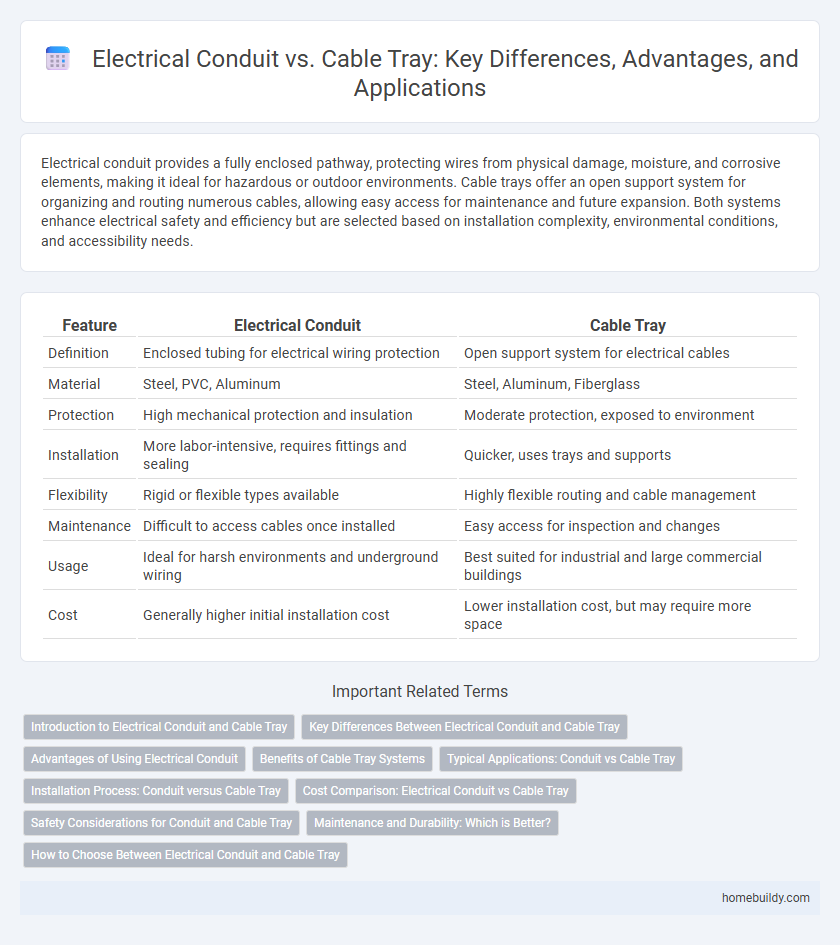Electrical conduit provides a fully enclosed pathway, protecting wires from physical damage, moisture, and corrosive elements, making it ideal for hazardous or outdoor environments. Cable trays offer an open support system for organizing and routing numerous cables, allowing easy access for maintenance and future expansion. Both systems enhance electrical safety and efficiency but are selected based on installation complexity, environmental conditions, and accessibility needs.
Table of Comparison
| Feature | Electrical Conduit | Cable Tray |
|---|---|---|
| Definition | Enclosed tubing for electrical wiring protection | Open support system for electrical cables |
| Material | Steel, PVC, Aluminum | Steel, Aluminum, Fiberglass |
| Protection | High mechanical protection and insulation | Moderate protection, exposed to environment |
| Installation | More labor-intensive, requires fittings and sealing | Quicker, uses trays and supports |
| Flexibility | Rigid or flexible types available | Highly flexible routing and cable management |
| Maintenance | Difficult to access cables once installed | Easy access for inspection and changes |
| Usage | Ideal for harsh environments and underground wiring | Best suited for industrial and large commercial buildings |
| Cost | Generally higher initial installation cost | Lower installation cost, but may require more space |
Introduction to Electrical Conduit and Cable Tray
Electrical conduit provides a protective tubing system to house electrical wiring, ensuring safety and compliance with electrical codes. Cable trays offer an open support structure designed to manage and organize large bundles of cables in commercial and industrial installations. Both solutions optimize cable management but differ in installation flexibility, protection level, and application environment.
Key Differences Between Electrical Conduit and Cable Tray
Electrical conduit provides a fully enclosed pathway for electrical wiring, offering superior protection against physical damage, moisture, and corrosion, making it ideal for harsh environments. Cable trays offer an open support system designed for organizing and routing large bundles of cables, allowing for easier access, inspection, and future cable additions or modifications. The choice between conduit and cable tray depends on factors such as environmental conditions, installation complexity, maintenance needs, and specific safety requirements in industrial or commercial electrical systems.
Advantages of Using Electrical Conduit
Electrical conduit provides superior mechanical protection for electrical wiring, preventing physical damage and environmental exposure. It supports enhanced safety by reducing fire hazards and facilitating grounding, which is crucial in industrial and commercial installations. Conduits also allow easier wire pulling and future upgrades compared to cable trays, ensuring long-term maintenance efficiency.
Benefits of Cable Tray Systems
Cable tray systems offer superior flexibility for routing and modifying electrical wiring compared to electrical conduit, enabling easier access for maintenance and future expansion. They provide enhanced ventilation, reducing heat buildup and improving cable longevity, which is crucial for high-density installations. Cable trays also allow for cost-effective installation and material savings by minimizing the need for connectors and fittings inherent in conduit systems.
Typical Applications: Conduit vs Cable Tray
Electrical conduit is typically used for protecting and routing individual electrical wires in residential, commercial, and industrial buildings where physical protection from mechanical damage and environmental exposure is critical. Cable trays, on the other hand, are designed for supporting and managing large bundles of cables in data centers, manufacturing plants, and large commercial installations where easy cable access and organization are essential. Both systems ensure electrical wiring safety, but conduit is preferred for tight, enclosed runs and installations requiring sealed protection, while cable trays offer flexibility for high-volume cable management and future expansion.
Installation Process: Conduit versus Cable Tray
Electrical conduit installation requires precise bending, cutting, and threading of metal or plastic pipes to protect and route electrical wiring, often necessitating skilled labor and specialized tools. Cable tray installation is generally faster and more straightforward, involving the mounting of trays with support brackets and laying cables inside without additional enclosures. The conduit system offers superior protection against physical damage and environmental factors, while cable trays provide easier access for cable management and future modifications.
Cost Comparison: Electrical Conduit vs Cable Tray
Electrical conduit systems typically have higher initial installation costs due to the need for precise bending, connectors, and labor-intensive fitting, while cable trays offer a more cost-effective solution with easier installation and less labor. Over time, cable trays provide savings in maintenance and adaptability for future cable additions compared to conduits' rigid structure. The overall cost-effectiveness depends on project scale, complexity, and future expansion requirements, with cable trays favored in large or frequently modified installations.
Safety Considerations for Conduit and Cable Tray
Electrical conduit offers superior protection against physical damage, moisture, and chemical exposure, enhancing overall safety in harsh environments. Cable trays provide easier access for maintenance and heat dissipation but require proper grounding and secure installation to minimize electrical hazards. Choosing between conduit and cable trays depends on specific site conditions, regulatory requirements, and the level of mechanical protection needed.
Maintenance and Durability: Which is Better?
Electrical conduit offers superior protection against environmental factors, enhancing durability and reducing maintenance frequency compared to cable trays. Conduits provide a sealed pathway that prevents moisture, dust, and mechanical damage, leading to longer service life and fewer repairs. Cable trays, while easier to install and modify, expose cables to external elements, increasing maintenance requirements and potential degradation over time.
How to Choose Between Electrical Conduit and Cable Tray
Choosing between electrical conduit and cable tray depends on factors such as environmental exposure, installation complexity, and maintenance needs. Electrical conduit provides superior protection against physical damage and moisture, making it ideal for harsh or outdoor environments, while cable trays offer easier access for wiring changes and support for large cable bundles in commercial or industrial settings. Evaluating project requirements, including budget constraints and future scalability, ensures the optimal choice for efficient cable management and safety compliance.
Electrical conduit vs Cable tray Infographic

 homebuildy.com
homebuildy.com